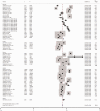Prevalence of preterm birth in Scandinavian countries: a systematic review and meta-analysis
- PMID: 37843530
- PMCID: PMC10683576
- DOI: 10.1177/03000605231203843
Prevalence of preterm birth in Scandinavian countries: a systematic review and meta-analysis
Abstract
Objectives: As welfare societies, Scandinavian countries share characteristics of equality related to healthcare access, gender, and social services. However, cultural and lifestyle variations create country-specific health differences. This meta-analysis assessed the prevalence of preterm birth (PTB) and its categories in Scandinavian countries.
Methods: A systematic search in key databases of literature published between 1990 and 2021 identified studies of the prevalence of PTB and its categories. Following the use of the Freeman-Tukey double arcsine transformation, a meta-analysis of weighted data was performed using the random-effects model and meta-prop method.
Results: We identified 109 observational studies that involved 86,420,188 live births. The overall pooled prevalence (PP) of PTB was 5.3% (PP = 5.3%, 95% confidence interval [CI] 5.1%, 5.5%). The highest prevalence was in Norway (PP = 6.2%, 95% CI 5.3%, 7.0%), followed by Sweden (PP = 5.3%, 95% CI 5.1%, 5.4%), Denmark (PP = 5.2%, 95% CI 4.9%, 5.3%), and Iceland (PP = 5.0%, 95% CI 4.4%, 5.7%). Finland had the lowest PTB rate (PP = 4.9%, 95% CI 4.7%, 5.1%).
Conclusions: The overall PP of PTB was 5.3%, with small variations among countries (4.9%-6.2%). The highest and lowest PPs of PTB were in Norway and Finland, respectively.
Keywords: Preterm birth; Scandinavian country; extremely preterm birth; moderate/late preterm birth; prevalence; systematic review; very preterm birth.
Conflict of interest statement
Declaration of conflicting interestsThe authors declare that they have no known competing financial interests or personal relationships that could have appeared to influence the work reported in this paper.
Figures









References
-
- Blencowe H, Cousens S, Oestergaard MZ, et al. National, regional, and worldwide estimates of preterm birth rates in the year 2010 with time trends since 1990 for selected countries: a systematic analysis and implications. Lancet 2012; 379: 2162–2172. DOI: 10.1016/s0140-6736(12)60820-4. - PubMed
-
- World Health Organization. 2018. Preterm birth. http://www.who.int/en/news-room/factsheets/detail/preterm-birth.
Publication types
MeSH terms
LinkOut - more resources
Full Text Sources
Research Materials
Miscellaneous

